|
Related FAQs: Wrasses In
General, Wrasses, Wrasse Selection, Wrasse Compatibility, Wrasse Feeding, Wrasse Diseases,
Related Articles: Wrasses, Anampses, Hogfishes/Bodianus, Maori Wrasses/Cheilinus &
Oxycheilinus, Fairy/Velvet
Wrasses/Cirrhilabrus, Coris
& Coris gaimard, Bird Wrasses/Gomphosus, Halichoeres, Cleaner Wrasses/Labroides, Tubelip Wrasses/Labropsis,
Leopard
Wrasses/Macropharyngodon, Pencil
Wrasses/Pseudojuloides, Razorfishes, Pseudocheilinus, Stethojulis, Thalassoma
Over to other Regional Accounts of
Wrasses:
To: A Fishwatcher's
Guide to the Fishes of the Cook Islands
/The Conscientious Marine
Aquarist
Wrasses of
the Cook Islands
Part I of
three
To Parts II, III
|
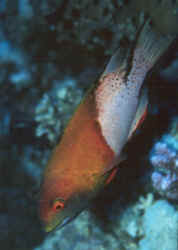
|
| Bob Fenner |
Bodianus anthioides
|
Wrasses, family Labridae. The Cooks are
?Wrasse rich? with fifty described species. These are a mix of some
used in the trade that shouldn?t, should be, others that could, would
be if enough we?re popularly known about them. Let?s elaborate on these
ideas by genus and species.
There are two Anampses here, and as with the genus everywhere,
they almost never live in captivity? even given the best capture,
holding and shipping techniques. The touchy ?Tamarin Wrasses? should be
left in the sea, or only tried by the more/most advanced reef
aquarists.
|
Anampses caeruleopunctatus Ruppell 1829, the
Blue-Spotted Wrasse (3), is often sold under the notorious
"miscellaneous" moniker. Most likely you will find
females offered and at way too small a starting size of a few
inches. Even the best initial size ones of 4-5 inches rarely live
for more than a few weeks. Grows to almost a foot and a half
overall length. Male and female shown in the wild.
|
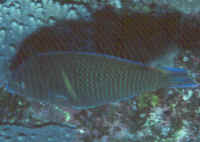 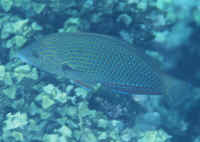
|
|
Anampses geographicus Valenciennes 1840, the
Geographic Wrasse. Indo-West Pacific. A giant of the genus at
more than a foot in maximum length. Variable in color, but
generally not a great beauty, and no hardier than the rest of the
Anampses. A rare import into the ornamental trade. Here in a
wholesalers facility in Fiji.
|
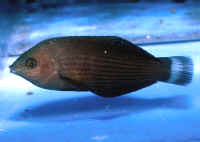
|
Four
species of Hogfishes, genus Bodianus could come out of the
Cooks. Two get too big for most aquarium use, Bodianus
bilunulatus, the Black Spot Hogfish or Tarry Hogfish at twenty two
inches maximum, and Bodianus loxozonus, the Blackfin Hogfish at
about eighteen. The other two are entirely suitable for easygoing fish
only systems and reefs lacking mollusks and crustaceans (which they
gladly eat); Bodianus anthioides, the Lyretail Hogfish, and
Bodianus axillaris, the Axilspot Hogfish.
| Bodianus anthioides (Bennett 1832), the
Lyretail Hogfish. Indo-Pacific, including the Red Sea (where this
picture was made) out to the Tuamotus. To nine inches in length. A
gentle beauty as the genus goes. Here, three and six inch
specimens in the Red Sea. |
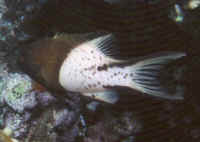 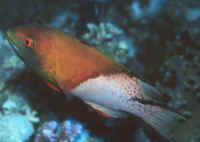
|
| Bodianus axillaris (Bennett 1832), the
Axilspot Hogfish. Indo-Pacific, including the Red Sea (where this
picture was made) out to the Tuamotus. To eight inches maximum
length. Two inch juvenile in captivity and six inch subadult in the
Maldives shown. |
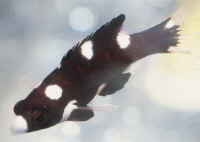 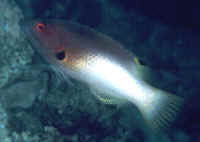
|
|
Bodianus bilunulatus (Lacepede 1801), the
Black Spot Hogfish or Tarry Hogfish to science, is often offered
retail. Punctuated distribution in the Indo-west Pacific
including Hawai'i, where these images were taken. Three inch
juvenile and six inch sub-adults shown. Grows to twenty two
inches in length in the wild.
|
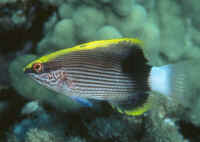 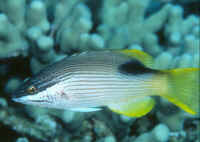
|
| Bodianus loxozonus (Snyder 1908), the
Blackfin Hogfish. Western Pacific: Japan, New Caledonia to
Polynesia. To nearly nineteen inches in length. Rarely
imported. Like other members of the genus, feeds primarily on
hard shelled benthic invertebrates (mollusks and crustaceans).
Juvenile of about three inches and six inch specimen at WSI
in Fiji, eight inch one underwater in Fiji. |
The rarely used Maori
Wrasses of the genera Cheilinus and Oxycheilinus ought to
get more attention, especially the ones in the Cooks, as they have a
few of the smaller species, and are found in good numbers in small
sizes here? yes, on the reef. Cheilinus chlorourus, the
Floral Wrasse and the Redbreasted, Cheilinus fasciatus, are both
very hardy and pleasing to look at. Cheilinus trilobatus, the
Tripletail Wrasse at two feet, and the world?s largest wrasse
species, the Humphead or Napoleon Wrasse, Cheilinus
undulatus at more than seven feet are too big for aquarium
use.
|
Cheilinus chlorourus (Bloch 1791), the
Floral Wrasse (1). Hardy, but not as good-looking as some of its
congeners. To twenty inches long in the wild; much smaller in
captivity. Indo-Pacific out to the Tuamotus. The first one a
small juvenile in Australia, the other in the Cooks.
|
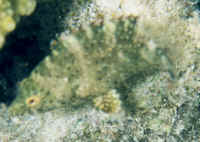 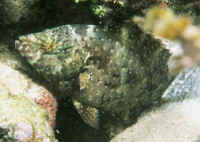
|
| Cheilinus fasciatus, (Bloch 1791), the
Redbreasted Wrasse. Indo-Pacific; Red Sea, East Africa to Samoa. To
sixteen inches overall length. Australian juvenile and Red Sea
adult |
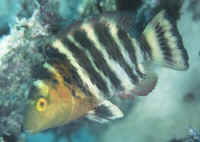 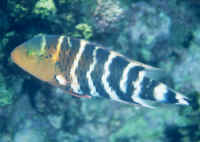 |
|
Cheilinus trilobatus Lacepede 1801, the
Tripletail Wrasse (2) we'll list as it is occasionally sold
in the business. This is another aquarium-tough, medium-shipper
that gets big (about two feet). Indo-Pacific; Red Sea to the
Tuamotus. Here are images from the Maldives, Red Sea and
Malaysia.
|
| The Humphead or Napoleon Wrasse, Cheilinus
undulatus Ruppell 1835 (2) looks like a tropical ornamental in
photographs that lack visual size clues, but it gets the size of
your couch! To seven feet (2.3m) and more than four hundred pounds.
at one foot in captivity and a five foot "pet" in French
Polynesia's Moorea |
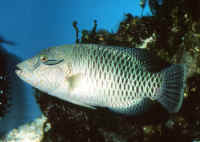 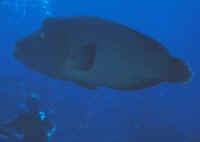
|
Oxycheilinus digrammus, the Cheeklined Wrasse is probably the
most commonly offered member of the genus. It and Oxycheilinus
unifasciatus, the Ring Tail or One-Banded Wrasse might do better
collected closer to the West, shortening in-bag times. (Show images of
all).
|
Oxycheilinus digrammus (Lacepede 1801), the
Cheeklined Wrasse (2) is probably the most commonly offered
member of the genus. Initially healthy specimens do well, but
most are received from the wild in poor condition. Indo-Pacific,
including the Red Sea, out to Samoa. To sixteen inches in length
in the wild. Here are some images taken in (the first) in the
Maldives, the other two in the Red Sea to illustrate how varying
this species appears.
|
|
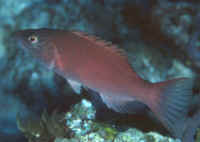
|
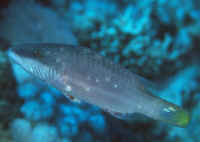
|
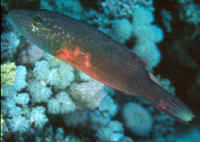
|
|
Oxycheilinus unifasciatus (Streets 1877),
the Ring Tail or One-Banded Wrasse (2) is the widest ranging
member of the genus. Found across the Pacific's Oceania
through the Indian Ocean and Red Sea, and growing only to about a
foot, it still does poorly in captivity. Formerly placed in the
genus Cheilinus. One on the reef in Roratonga
|
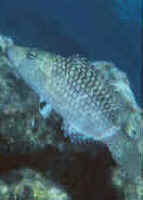
|
|
Genus Cheilio: I'll mention the
seagrass-dwelling Cigar Wrasse, Cheilio inermis (Forsskal
1775) (3), only because it occasionally is offered in pet-fish
markets, and rarely lives in captivity. Indo-Pacific, including
the Red Sea, out to Hawai'i. To twenty inches in length. Here
is one in the Gilis, Indonesia in a typical flanking behavior,
disguised with a Goatfish.
|
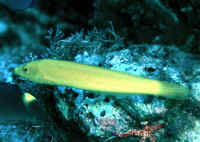
|
|
Only one species Fairy or Velvet
Wrasse (genus Cirrhilabrus) is found in the Cooks but it?s
a winner. Cirrhilabrus scottorum, Scott's Wrasse. Here is one
in a cubicle at Chip Boyle's collection business in
Roratonga, Cook Islands, the other at a S. Cal. retailers.
|
| Cirrhilabrus scottorum Randall & Pyle
1989, Scott's Wrasse. South Pacific. To five inches in length.
Here is one in a cubicle at Chip Boyle's collection business in
Roratonga, Cook Islands, the other at a S. Cal. retailers. |
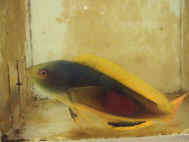 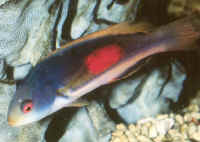
|
|
Do they have
Coris Wrasses? Of Coris! (sorry about that). There are
three species in the Cooks, including the
Coris to many, C. gaimard. The other members here are all
about the same suitable? for rough and ready fish only marine
systems. Besides the ever-active (except at night when it?s
asleep below the sand), there?s Coris aygula, the Twinspot
or Clown Coris for fish only marine aquarium species. (Show both
through development)
|
|
Coris aygula Lacepede 1801, the Twinspot or
Clown Coris (2), is oh-so-cute when little; at about 3-5 inches
it starts to transform into a light in the front, dark in the
back female. But as they say on late night TV, "Wait,
there's more". At a foot or so in length females change
again to darkish green with a white body band males that grow to
three plus feet in length! Indo-Pacific, including the Red Sea to
the Line Islands in distribution. Below are a three inch
juvenile in captivity, and a six inch female and two foot male in
the Red Sea.
|
|
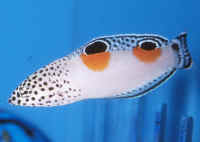
|
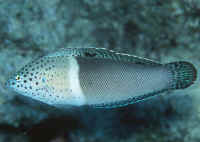
|
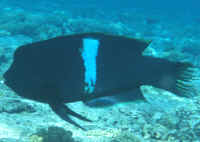
|
|
Coris gaimard (Quoy & Gaimard 1824), the
Yellowtail Coris or Gaimard's Wrasse is THE Coris Wrasse to
most hobbyists (1). Depending on life stage this fish also goes
by the common appellations as the Red (as young) and Yellowtail
Coris. To a mere sixteen inches in length. Indo-Pacific out to
Hawai'i. where these images of a juvenile, female and male
were made.
|
| Coris roseoviridis Randall 1999. Eastern
Central Pacific; French Polynesia and Cook Islands. To eight inches
in length. |
no image imago
|
To Parts II, III
|
|

